Hypoxis
Hypoxis L.
Family: Hypoxidaceae
Common names: yellow stars, star lily, african potato (Eng.); sterretjie, Afrika-patat (Afr.); inkomfe, ilabatheka (isiZulu)
Introduction
Hypoxis, a well-known genus of the family Hypoxidaceae, easily recognizable by its bright yellow star-shaped flowers and strap-like leaves, has a long history of medicinal use on the African continent and is currently being used in South Africa in primary health care as an immune booster for patients with HIV/AIDS.
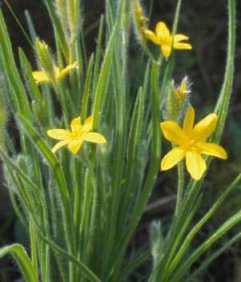
Description
Description
Being geophytic herbs, Hypoxis plants overcome winter conditions in the form of an underground rootstock called the corm. Corms are hard, fleshy, mucilaginous and white or yellow-orange within. Sliced corms, when exposed to the atmosphere, turn black with oxidation. In spring, a new set of leaves grows from the apex of the corm. In most species, leaves are arranged one above the other in three rows that radiate outwards. In some species, leaf bases are enclosed in a sheath, forming a false stem. Leaves range from linear to broadly lance-shaped, are hairy in most species and die back over the winter months. Flowering stems appear with the leaves after the first rains in spring. They are unbranched, with 2-12 flowers per stalk. Flowers are symmetrical with 6 tepals, rarely 4 or 8, are bright yellow, giving the genus its common name "yellow stars". Only in two taxa, H. membranacea and H. parvula var. albiflora are the flowers white. The fruit is a capsule that splits across its diameter to expose the small black seeds.
Distribution and habitat
Distribution description
Hypoxis has an estimate of 90 species world-wide and is almost cosmopolitan in distribution, occurring in Africa, North and South America, southeastern Asia and Australia. In Africa, the genus is widespread south of the Sahara, with a concentration of about 41 species in southern Africa. Hypoxis is primarily a summer rainfall genus with a large number of species in the eastern region of South Africa. Seven species occur in the Cape winter rainfall region, none of which are endemic to the region. Eleven species of the 41 species are inland endemics, being restricted to altitudes higher than 1 000 m whereas the remaining species extend from the coast to the interior of southern Africa. Hypoxis is predominantly a grassland genus, preferring full sunlight. A few species grow on cliff faces or in forest shade.
Derivation of name and historical aspects
History
The name Hypoxis is coined from the Greek words hypo meaning below and oxy referring to the pointed base of the ovary or fruit.
Ecology
Ecology
Hypoxis flowers are short-lived and are pollinated by solitary and honey bees. Pollen grains in Hypoxis are yellow and are visible through the transparent pollen sacs of honey bees visiting flowers. The fruiting capsule in Hypoxis, called a pyxis, splits along its diameter and the upper portion of the capsule drops off, exposing the black seeds. In a few species such as H. angustifolia, the remaining lower portion of the capsule splits further longitudinally to aid dispersal.
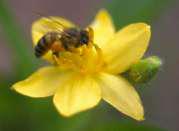
Uses
Use
In the genus, two species, H. hemerocallidea and H. colchicifolia are most sought after for their use in African traditional remedies as well as for preparation of herbal teas and tinctures. This places demand on existing populations of these species in southern Africa and as such, the species are under threat.
The rootstock of Hypoxis is used in various ways in South Africa. H. hemerocallidea and H. colchicifolia rootstocks were used by Zulu traditional healers for centuries in the treatment of urinary infections, heart weakness, internal tumours and nervous disorders. Corms of the latter species are used as an emetic against fearful dreams. The Sotho people use Hypoxis as a charm against lightning and storms. H. argentea has small white rootstocks, and in times of famine the rootstocks are boiled or roasted by the Sotho and Xhosa people as a source of food.
One species in particular, H. hemerocallidea (earlier name H. rooperi) tagged by entrepreneurs as a 'wonder herb' and 'miracle cure', dominates the South African herbal enterprise. Corms of H. hemerocallidea are being used to alleviate many immune related ailments such as the common cold, flu, arthritis, tumours, cancer and HIV/AIDS. The southern African public has resorted to self-medication with all kinds of preparations from Hypoxis corms, that have become available over the counter in health stores. The value of the plant is in its content of a sterol called hypoxoside, which once in the human gut, readily converts to rooperol, a biologically active compound that balances the immune system. Preparations of hypoxoside are being used in primary health care in South Africa to boost the immunity in HIV/AIDS patients. The genus has great potential as a source of new drugs with immuno-modulatory properties and as such, is of economic value. However, clinical trials are first needed to confirm the anti-inflammatory and immuno-modulatory properties of Hypoxis.
Growing Hypoxis
Grow
As the pictures show, most Hypoxis species are attractive for development as garden ornamentals. Species suited for garden beds are those with small corms and soft leaves like H. angustifolia and H. membranacea which spread quickly through multiplication of the rootstock to form a mass of plants. Hardy species with large corms and strong leaves like H. hemerocallidea, H. colchicifolia, H. obtusa and H. acuminata are fairly easy to maintain once established in a garden. Seeds of Hypoxis germinate better if sown soon after maturity.
The species described below were selected to give an idea of the morphological diversity in Hypoxis, and to illustrate the medicinally important species and those with potential for horticulture. The first four species are common in grasslands in the summer rainfall region.
Species
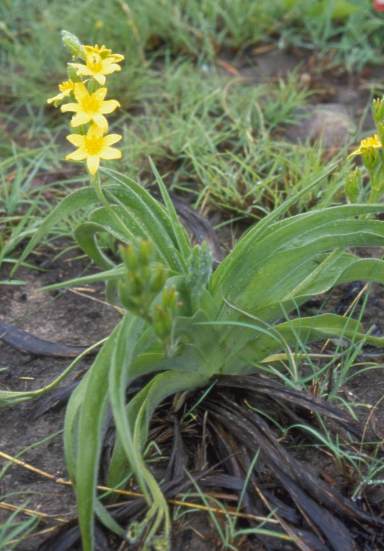
Hypoxis hemerocallidea (previous name H. rooperii)
Best known member of the genus. Plants about 100 to 500 mm tall. Leaves clearly 3-ranked, distinctly arching in the shape of a sickle and are hairy all over. Widespread in the summer rainfall region of South Africa, from coast to interior, extending nothwards into Botswana where populations become fewer.
Used for centuries in African traditional medicine and recently recognized in the alternative medicine trade as a 'wonder cure' for its immune-boosting properties.
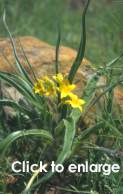
Hypoxis obtusa
Very similar to H. hemerocallidea in appearance but differing in its leaves being stiff, twisting with age, and with margins white due to overlapping hairs. Widespread in southern Africa.
Used in the making of a floor polish for huts by local tribes in the Estcourt area of KwaZulu-Natal. A very floriferous species and has potential for horticulture. Occasionally hybridizes with H. rigidula.
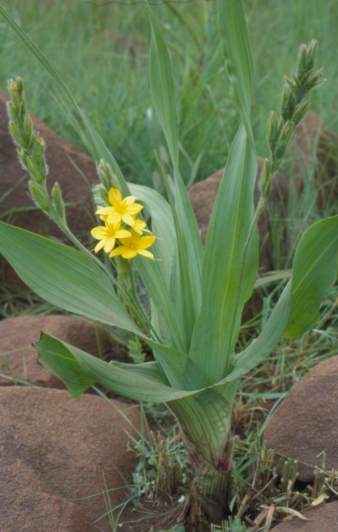
Hypoxis colchicifolia
Second most popular species in the medicinal trade in South Africa. Plants tall, 250-600 mm in height. Leaves are long and wide and their bases wrap over to form a false stem, giving the plant a tall, erect appearance. Leaves are tough and almost hairless. Widespread from the coast to the interior of southern Africa.
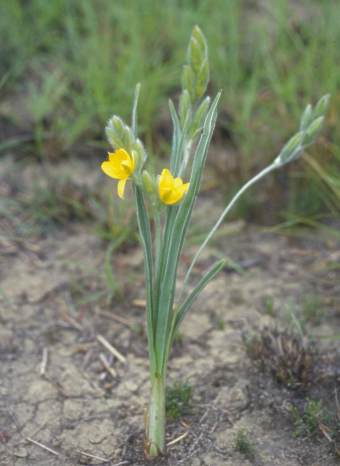
Hypoxis rigidula
Similar to H. colchicifolia in habit, differing in its long but narrow leaves that are soft and bend backwards. Leaves are hairy all over have strong fibres and are used to make rope and hut trimmings. Two varieties are recognized by the density of hairs on leaves: In H. rigidula subsp. rigidula, the leaves are sparsely hairy with hairs lying mainly between the ribs; in H. rigidula var. pilosissima, they densely covered with hairs on both surfaces.

Hypoxis angustifolia
One of the few species used in the nursery trade as it is suitable for cultivation due to its spreading rootstock. Plants are 70 to 300 mm tall and are clump-forming. Leaves are soft and of a flaccid nature. Two varieties are recognized, based on width of leaves. Common along shaded cliff faces in the Eastern Cape, where it grows alongside and occasionally hybridizes with H. membranacea.
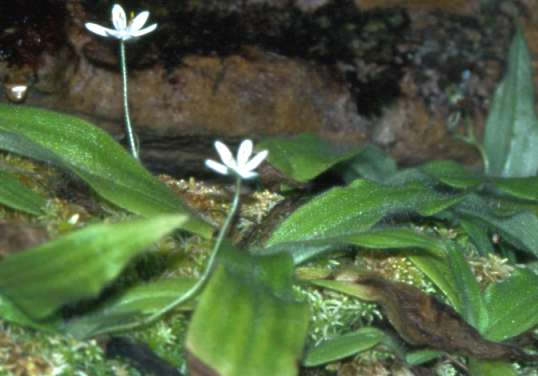
Hypoxis membranacea
A white-flowered, fragile species, widespread from coast to interior in South Africa. Plants small, 40 to 100 mm tall. Corms small, about 10 mm in diameter. Leaves membranous. Flowering stalk with 1 to 3 flowers,which are Flowers white. Clump-forming and easily spreading like H. angustifolia.
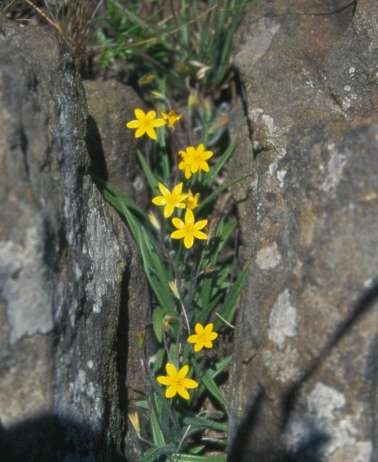
Hypoxis parvula
A mountain endemic occurring in South Africa, Swaziland and Lesotho. Prefers moist, semi-shaded habitats among boulders. Plants small, similar in habit to H. membranacea. Flowering stalk with a single flower. Two varieties are recognized by flower colour. Flowers in H. parvula var. parvula are yellow and those of H. parvula var. albiflora are white like in H. membranacea. Excellent for alpine gardens. Produces occasional hybrids with Rhodohypoxis.
References
- Gillmer, M. & Symmonds, R. 1999. Seed collection and germination: Hypoxis hemerocallidea. Plantlife 21: 36, 37.
- Snijman, D.A. 2000. Hypoxidaceae. Cape plants. A conspectus of the Cape flora of South Africa. Strelitzia 9: 108-110.
- Snijman, D.A. & Singh, Y. 2003. Hypoxidaceae. In G. Germishuizen & N.L. Meyer, Plants of southern Africa: an annotated checklist. Strelitzia 14: 1071-1074. National Botanical Institute, Pretoria.
- Singh, Y. 1999. Hypoxis: yellow stars of horticulture, folk remedies and conventional medicine. Veld & Flora 85: 123-125.
- Van Wyk, B-E. 2000. People's plants. Briza Publications, Pretoria.
Credits
Yashica Singh
Natal Herbarium, Durban
April 2004
Plant Attributes:
Plant Type: Bulb
SA Distribution:
Soil type:
Flowering season:
PH:
Flower colour:
Aspect:
Gardening skill:
Special Features:
Horticultural zones






Rate this article
Article well written and informative
Rate this plant
Is this an interesting plant?
Login to add your Comment
Back to topNot registered yet? Click here to register.